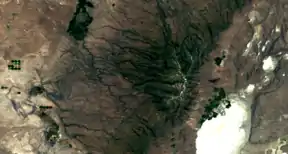| Steens Mountain | |
|---|---|
 Steens Mountain near Andrews, Oregon | |
| Highest point | |
| Elevation | 9,738 ft (2,968 m) NAVD 88[1] |
| Prominence | 4,373 ft (1,333 m)[1] |
| Listing | |
| Coordinates | 42°38′11″N 118°34′36″W / 42.636418°N 118.576717°W[1] |
| Naming | |
| Etymology | Enoch Steen |
| Geography | |
 Steens Mountain Location in Oregon | |
| Location | Harney County, Oregon, U.S. |
| Topo map | USGS Wildhorse Lake |
| Geology | |
| Mountain type | Fault block mountain, volcanic mountain, shield volcano |
| Volcanic field | Columbia River Basalt Group |
| Last eruption | Before Pleistocene |
| Climbing | |
| Easiest route | Short hike from gravel road |
Steens Mountain is in the southeastern part of the U.S. state of Oregon, and is a large fault-block mountain.[2][3] Located in Harney County, it stretches some 50 miles (80 km) north to south, and rises from the west side the Alvord Desert at elevation of about 4,200 feet (1,300 m) to a summit elevation of 9,738 feet (2,968 m). Steens Mountain is not part of a mountain range but is properly a single mountain, the largest of Oregon's fault-block mountains.[4][5]
The Steens Mountain Wilderness encompasses 170,166 acres (68,864 ha) of Steens Mountain.[6] 98,859 acres (40,007 ha) of the Wilderness are protected from grazing and free of cattle.[7]
History
The mountain was called the "Snowy Mountains" by John Work, one of the fur traders who were the first Europeans in the area. It was renamed in 1860 for United States Army Major Enoch Steen, who fought and drove members of the Paiute tribe off the mountain.[8][9] American Indians used the Steens Mountain, particularly Big Indian Gorge.[5]: 100
Geography
Geology

Steens Mountain is the remnant of a long shield volcano.
The east face of Steens Mountain is composed mainly of basalts stacked one upon another. Lava flows several hundreds of feet thick inundated the region between 17 and 14 million years ago.[10][11][12] Chemical data from magma deposits from the area reveal three distinct stages of volcanism.[13]
Layers of clay and volcanic dust show over forty lava flows on Steens Mountain. Most lava layers reach to 3,000 feet (910 m) thick or more in some areas. As the surface cracked, peaks and valleys were formed. Erosion and landfalls continue to modify the faces of the cliffs along the mountain.[5]: 97 The sediment bedding is roughly horizontal, evidence to the absence of compressional forces.[14] The white sediments consist primarily of stratified acidic tuffs. While rain hasn't been a main contributor to erosion, ice and snow melt are the main sources of erosion on Steens Mountain.[5]: 97
Flora and fauna
.jpg.webp)
Vegetation in the Steens Mountain Wilderness varies greatly according to elevation. Common plants include sagebrush, juniper, various species of bunchgrass, mountain mahogany, aspen, mountain meadow knotweed, and false hellebore. Other vegetation endemic to Steens Mountain includes Steens paintbrush (Castilleja pilosa var. steenensis), moss gentian (Gentiana fremontii), Steens Mountain penstemon (Penstemon davidsonii var. praeteritus), Steens Mountain thistle (Cirsium peckii), a dwarf blue lupine, and Cusick's buckwheat (Eriogonum cusickii).[15][16][17]
Steens Mountain is distinctive in its absence of conifers, especially Ponderosa Pine and Douglas Fir, at elevations in which they would normally be found – from 5,500–8,000 feet (1,700–2,400 meters) above sea level. Although other mountains of the Great Basin also lack conifers, Steens Mountain is the largest mountain area without conifers. One possible cause of the absence of conifers is the isolation of Steens Mountain, although lack of seed dispersal by bird species such as Clark's Nutcracker may also be a factor. It is also possible that prehistoric fires, including fires used by Native Americans, eradicated the conifer population.[18] Home to a wide variety of animals, the area is primarily known for birding, hunting, and fishing. Birds here include Golden eagles, owls, and the protected sage grouse.[19] Other animals found in the area include rattlesnakes, scorpions, elk, bighorn sheep, pronghorn antelope, and cougars.[20] The area is home to wild horses. Drawing much controversy, the Bureau of Land Management engages in wild horse roundups every few years, employing helicopters to herd the horses.[21][22] Historically, Steens Mountain Wilderness was once home to grizzly bears; a skull was unearthed in nearby Malheur Lake.[23] In the 1970s, a wolverine was trapped and released on Steens Mountain.[24]
Climate
| Climate data for Steens Mountain 42.6400 N, 118.5808 W, Elevation: 9,318 ft (2,840 m) (1991–2020 normals) | |||||||||||||
|---|---|---|---|---|---|---|---|---|---|---|---|---|---|
| Month | Jan | Feb | Mar | Apr | May | Jun | Jul | Aug | Sep | Oct | Nov | Dec | Year |
| Mean daily maximum °F (°C) | 29.3 (−1.5) |
28.7 (−1.8) |
31.6 (−0.2) |
36.2 (2.3) |
45.4 (7.4) |
55.0 (12.8) |
67.3 (19.6) |
67.0 (19.4) |
59.1 (15.1) |
46.7 (8.2) |
34.0 (1.1) |
28.4 (−2.0) |
44.1 (6.7) |
| Daily mean °F (°C) | 22.3 (−5.4) |
20.5 (−6.4) |
22.5 (−5.3) |
25.9 (−3.4) |
34.2 (1.2) |
42.8 (6.0) |
53.4 (11.9) |
53.1 (11.7) |
45.7 (7.6) |
35.7 (2.1) |
26.4 (−3.1) |
21.5 (−5.8) |
33.7 (0.9) |
| Mean daily minimum °F (°C) | 15.3 (−9.3) |
12.4 (−10.9) |
13.5 (−10.3) |
15.6 (−9.1) |
23.0 (−5.0) |
30.6 (−0.8) |
39.6 (4.2) |
39.1 (3.9) |
32.3 (0.2) |
24.6 (−4.1) |
18.9 (−7.3) |
14.5 (−9.7) |
23.3 (−4.8) |
| Average precipitation inches (mm) | 6.81 (173) |
5.34 (136) |
6.40 (163) |
5.87 (149) |
4.92 (125) |
2.74 (70) |
0.57 (14) |
0.63 (16) |
1.05 (27) |
2.95 (75) |
4.93 (125) |
7.57 (192) |
49.78 (1,265) |
| Source: PRISM Climate Group[25] | |||||||||||||
Environmental protection
.jpg.webp)
On October 24, 2000, President Bill Clinton approved the Steens Mountain Cooperative Management and Protective Act. The act was created by local landowners in cooperation with local and national government representatives in response to a proposed National Monument. This act created the Steens Mountain BLM Cooperative Management and Protection Area, a 425,000-acre (1,720 km2) area. This law protects 1,200,000 acres (4,860 km2) from mining, and 100,000 acres (405 km2) from cattle grazing.[26]
Activities
The west slope of Steens Mountain is traversed by a 52-mile (84 km) loop road, which is suitable for passenger vehicles.[6] The road reaches an elevation of 9,700 feet (3,000 m), making it the highest road in Oregon. It is possible to drive almost to the summit of the mountain and to other viewpoints such as Kiger Gorge.[27] Steens Mountain is also host to Steens Mountain High Altitude Running Camp.[28]
Other recreational activities enjoyed on and around Steens Mountain are camping, picknicking, bicycling, hiking, hunting, sightseeing, soaring, and exploring. There are numerous hot springs along the base of Steens Mountain, including Alvord Hot Springs.[29] Far from city lights, stargazing is also popular.
See also
References
- 1 2 3 "Steens Mountain, Oregon". Peakbagger.com. Retrieved December 27, 2009.
- ↑ "Steens Loop Tour Route". Travel Oregon. Archived from the original on November 20, 2015. Retrieved April 27, 2016.
- ↑ "The Steens Loop Tour Route" (PDF). Scenic Byways, Oregon Department of Transportation. Archived (PDF) from the original on September 19, 2015. Retrieved April 27, 2016.
- ↑ "Steens Mountain". oregonencyclopedia.org. Retrieved April 25, 2022.
- 1 2 3 4 Conkling, C., Jackman, E. R., & Scharff, J. (1967). Steens Mountain in Oregon's high desert country. Caxton Press. Retrieved April 25, 2022
- 1 2 "Steens Mountain". Bureau of Land Management. April 10, 2017. Archived from the original on August 25, 2015. Retrieved August 28, 2015.
- ↑ "Steens Mountain Wilderness". Wilderness.net. Archived from the original on September 23, 2016. Retrieved January 4, 2016.
- ↑ McArthur, Lewis A.; Lewis L. McArthur (2003) [1928]. Oregon Geographic Names (7th ed.). Portland, Oregon: Oregon Historical Society Press. ISBN 0-87595-277-1.
- ↑ Loy, Willam G.; Stuart Allan; Aileen R. Buckley; James E. Meacham (2001). Atlas of Oregon. University of Oregon Press. p. 25. ISBN 0-87114-101-9.
- ↑ "Southeast Oregon Basin and Range". SummitPost.org. Retrieved May 7, 2011.
- ↑ "Andesitic and basaltic rocks on Steens Mountain". United States Geological Survey. Archived from the original on December 26, 2013. Retrieved April 27, 2016.
- ↑ Camp, Victor E.; Ross, Martin E.; Hanson, William E. (2003), "Genesis of flood basalts and Basin and Range volcanic rocks from Steens Mountain to the Malheur River Gorge, Oregon", Geological Society of America Bulletin, 115 (1): 105–128, Bibcode:2003GSAB..115..105C, doi:10.1130/0016-7606(2003)115<0105:GOFBAB>2.0.CO;2
- ↑ Moore, N. E.; Grunder, A. L.; Bohrson, W. A.; Carlson, R. W.; Bindeman, I. N. (2020). "Changing Mantle Sources and the Effects of Crustal Passage on the Steens Basalt, SE Oregon: Chemical and Isotopic Constraints". Geochemistry, Geophysics, Geosystems. 21 (8). doi:10.1029/2020GC008910. ISSN 1525-2027. S2CID 225354222.
- ↑ "The Geomorphology and Volcanic Sequence of Steens Mountain in Southeastern Oregon". University of Washington Publications in Geology. Retrieved April 25, 2022.
- ↑ Sullivan, William L. (2002). Thurman, Paula (ed.). Exploring Oregon's Wild Areas (3rd ed.). The Mountaineers Books. ISBN 978-0-89886-793-0.
- ↑ St. John, Alan D. (2007). Oregon's Dry Side: Exploring East of the Cascade Crest. Timber Press. ISBN 978-0-88192-829-7.
- ↑ Mansfield, Donald H. (2000). Flora of Steens Mountain. OSU Press. ISBN 978-0-87071-471-9.
- ↑ Mansfield, Donald (1995). "The Unique Botany of Steens Mountain: The Rare and Endemic Plants" (PDF). Archived (PDF) from the original on March 4, 2016. Retrieved January 4, 2016.
- ↑ "Steens Mountain". Portland Audubon Society. 2020. Archived from the original on October 17, 2020. Retrieved October 12, 2020.
- ↑ "2017 Oregon Cougar Management Plan" (PDF). Oregon Department of Fish and Wildlife. 2017. Archived (PDF) from the original on September 20, 2020. Retrieved October 12, 2020.
- ↑ Darling, Dylan J. (July 11, 2015). "Steens Mountain wild horse round up still on, for now". Bend Bulletin. Archived from the original on November 6, 2021. Retrieved November 6, 2021.
- ↑ "Bureau of Land Management to begin South Steens Herd Management Area wild horse gather". Bureau of Land Management. September 16, 2020. Archived from the original on April 3, 2021. Retrieved November 6, 2021.
- ↑ Shaw, Ethan (2015). "Oregon as Grizzly Country". Archived from the original on November 8, 2020. Retrieved November 1, 2020.
- ↑ "Wildlife Viewing: Wolverine". Oregon Department of fish and Wildlife. Archived from the original on November 7, 2020. Retrieved November 1, 2020.
- ↑ "PRISM Climate Group, Oregon State University". PRISM Climate Group, Oregon State University. Retrieved September 28, 2023.
To find the table data on the PRISM website, start by clicking Coordinates (under Location); copy Latitude and Longitude figures from top of table; click Zoom to location; click Precipitation, Minimum temp, Mean temp, Maximum temp; click 30-year normals, 1991-2020; click 800m; click Retrieve Time Series button.
- ↑ Karras, Christy (August 16, 2001). "Politicians dedicate Steens Mountain preserve". Seattle Post Intelligencer. Archived from the original on November 6, 2021. Retrieved April 2, 2008.
- ↑ "Steens Mountain". Harney County Chamber of Commerce. Archived from the original on September 24, 2015. Retrieved April 27, 2016.
- ↑ "Steens Mountain High Altitude Running Camp". Archived from the original on May 2, 2016. Retrieved April 27, 2016.
- ↑ Alt, David D; Hyndman, Donald W (1978). Roadside Geology of Oregon. Missoula: Mountain Press Publishing Company. ISBN 9780878420636.
External links
- "Steens Mountain". Geographic Names Information System. United States Geological Survey, United States Department of the Interior.
- "Steens Mountain Wilderness". Wilderness.net. Retrieved April 2, 2008.
- "Virtual aerial image looking south across Steens Mountain and the Alvord Desert". California Geographical Survey. Retrieved April 2, 2008.
- Two more Sentinel-2 satellite images of Steens Mountain
- Steens Mountain Cooperative Management and Protection Area – BLM page